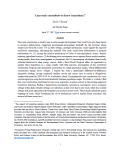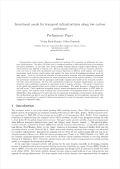
Transportation mode choices, distances traveled and resulting CO2 emissions are influenced by transport infrastructures. The latter will either lock-in transport patterns in high-emitting modes or accompany low-carbon pathways. At the same time, future mobility demand increase requires rapid build-up of new infrastructures and upgrade of existing ones. Here the authors quantify investments needs for transport infrastructures over time to reach both development and climate objectives in different world regions. Investments needs between world regions are compared and the main factors determining investment needs for each region are analyzed. To do so, the authors build an ensemble of socio-economic scenarios with the integrated assessment model Imaclim-R combining alternatives on model parameters determining mobility patterns. The authors estimate the investments consistent with the passengers and freight transportation trends in the scenarios and identify their main determinants.
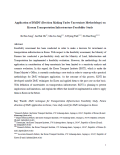
Feasibility assessment has been conducted in order to make a decision for investment on transportation infrastructure in Korea. With respect to the feasibility assessment, the Ministry of Finance has conducted a pre-feasibility study and the Ministry of Land, Infrastructure and Transportation has implemented a feasibility evaluation. However, the methodology for real application in consideration of deep uncertainty has been limited to a sensitivity analysis and scenario evaluation. In this regard, the Korea Transport Institute (KOTI), which is under the Prime Minister’s Office, is currently conducting a case study in order to come up with a practical methodology for DMU techniques application. As the outcome of this process, KOTI has developed suitable DMU techniques for Korea and applied them to the past case on that basis. With definition of uncertainties on transportation infrastructure, KOTI is planning to present implications and limitations, and explain the efforts that should be implemented in order to apply them in Korea in the future.
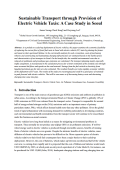
As a prelude to scaled-up deployment of electric vehicles, this paper examines the economic feasibility of replacing the current fleet of fossil fuel taxis in Seoul with electric vehicle (EV) taxis by phasing the former out based on their opertional lifetime. In the cost-benefit analysis for such a transition, costs of purchasing vehicles and constructing and maintaining charging infrastructure are estimated based on the market prices and characteristics of taxi transport in Seoul. On the benefit side, the avoided environmental costs due to reduced air pollutants and greenhouse gas emissions are calculated. The transport planning model, especially traffic assignment, is incorporated in the calculation process for a better estimation of the avoided costs through more accurate link flows and speeds on the road network. Savings from the fuel switch to electricity from liquefied petroleum gas for taxis are also estimated. The resultant benefit-cost ratio signifies economic viability of the deployment of EV taxis. The results of the study are encouraging and could be a good piece of rationale to push forward with electric vehicles.
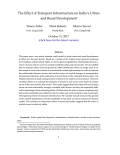
This paper uses a two-sector domestic trade model to study urban and rural development in India over the past decade. Based on a version of the market access approach proposed by Donaldson and Hornbeck (2016), the authors derive general equilibrium relationships between a sector’s income and it’s access to markets in both the urban and rural sectors. Satellite data are used to measure urban and rural growth in 5,900 sub-districts where areas are assigned to either urban or rural sectors based on a threshold for urban light intensity. In order to estimate the relationship between income and market access, the authors exploit changes in transportation infrastructure that have led to reductions in travel times on the computed shortest path. The implied reduction in trade costs generates variation in the market access measures. This time variation allows to estimate the elasticity of income in each sector with respect to market access in the own and the other sector. The results suggest that both urban and rural market access are each individually strongly correlated with income, but they are empirically difficult to disentangle when estimating jointly.
